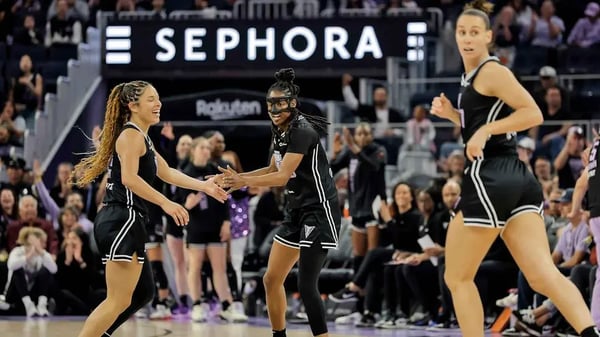 Aug 7, 2025; Montreal, QC, Canada; Victoria Mboko (CAN) tournament winner against Naomi Osaka (JPN) holds her trophy at IGA Stadium. Mboko rose 61 places in the WTA rankings to a career-high world No. 24 and how has $1.2M in career earnings after winning her first-ever WTA Tour title in Montreal. Credit: David Kirouac-Imagn Images
Aug 7, 2025; Montreal, QC, Canada; Victoria Mboko (CAN) tournament winner against Naomi Osaka (JPN) holds her trophy at IGA Stadium. Mboko rose 61 places in the WTA rankings to a career-high world No. 24 and how has $1.2M in career earnings after winning her first-ever WTA Tour title in Montreal. Credit: David Kirouac-Imagn Images
As long as there have been sports there have been rules, and as long as there have been sports in college there have been rules about who can participate and how.
If you’re a fan of women’s sports, chances are you tune in when the year’s numbers come out and we get to see the receipts on how our never-ending crusade for pay equity in sports is really going. It’s always a bit of a reality check when I see how few women still rank within the top-paid athletes, but there’s another statistic that consistently catches my eye, and it has nothing to do with gender pay disparity. Every year, the vast majority of the highest paid female athletes are tennis players. In 2024, 11 out of the top 15 highest paid female athletes were tennis athletes. So what’s behind the big paychecks in tennis, and what can other sports learn from their example?
Tennis is made by and for the richest rich
Tennis has its roots (and branches and leaves let’s be honest) in country clubs and ironed tennis whites. It originally was a sport built for rich people by rich people, and the prestige of the sport remains, drawing luxury brands and big spenders. Big sponsors means big prize money, which means big winnings for athletes. Front Office Sports recently published a report on how Rolex has cornered the tennis market , and what we love about Rolex? They invest in the women’s game right alongside the men’s. Furthermore, luxury sponsors only make up part of tennis’ income. Tennis spectating is about oh so much more than the game: it’s about status and prestige, and patrons pay accordingly. For example, Wimbledon has a special investment opportunity called debentures, which entitles investors access to prime seats and exclusive facilities. For the next block of debentures, expect to shell out over $150,000. Then you still have to pay for the prime seats if you want to watch a match, which can cost up to $5,000.
Billie. Jean. King.
When you talk about money in women’s tennis, it’s impossible (not to mention irresponsible) to leave out Billie Jean King. Because tennis was first played in country clubs, in its beginnings it was considered low class to be paid to play.
Tennis players, of either gender, weren’t paid professionals until the 1960s.
Although there was, of course, a whole slew of sexist bullshit about why women should be excluded from early negotiations, BJK and her contemporaries saw to it that women were competing in paid tournaments right alongside the men by the 1970s. Therefore, unlike soccer or football or basketball or any other major men’s sports league, tennis has been shared real estate almost from the beginning. Since then, tennis has become one of the only sports that hosts men’s and women’s tournaments concurrently, with equal prize money. As the game has grown, it has benefitted both men and women equally, which is so rare in the sports space. So thank you BJK, for huge checks.

November 2024; The Italian team celebrates after winning the Billie Jean King Cup over Slovakia in Málaga, Spain Credit: David Kirouac-Imagn Images
Plenty of cash, but few cashing in
There is a dark side to the tennis payment plan, and that’s that it’s not for everyone. Tennis is an extremely expensive sport, and, as there is not one federation that hosts all of the tournaments or employs all the players, a base salary and benefits remain elusive. In order to earn money, you have to play big tournaments, and in order to make the draw at those tournaments, you need a high ranking (earned by playing in smaller tournaments). For many players, after footing the cost of a year of qualifying tournaments, their bank accounts are rarely in the positive.
Players have to choose between flying a coach or physio out with them to tournaments, and being able to pay rent, or eat. Ultimately many decide to go it alone, competing against players who are much better supported and prepared.
So, while there is a huge pool of money at the end of the tennis rainbow, it’s incredibly hard to crack onto the court where that money is made. Once you’re a player with a high ranking and you get invited to all the big tournaments? Often you get paid 5 figures for a loss in the first round. So while many struggle to make ends meet, the big names keep collecting, which partly explains the lopsided paychecks.
Female athletes are great influencers
Tennis has realized what other industries are still learning: female athletes are the best influencers in the business. Our research has shown that “Women’s sports fans are 2.8 times more likely to purchase a product recommended by a woman athlete rather than by another type of influencer.” Brands haven’t hesitated when it comes to making tennis stars the faces of their marketing campaigns, but they have to pay for the privilege. With a huge global audience, female tennis stars know their worth, and much of their multi-million dollar salaries come from lucrative sponsorship agreements.
What else?
Tennis players can have very long careers, meaning there are not only many more years of earning potential compared with other sports, but also many years of sponsorship potential. Investing in a young tennis star could mean high global visibility for a brand for decades to come. Tennis also is played all year round, meaning there are plenty of opportunities to play, and plenty of opportunities to activate around a player. The individual nature of tennis also means that tennis players keep a greater percentage of their earnings than players in team sports, who often share money with organizations, leagues and teammates.
Adding all this up, it no longer seems surprising that female tennis athletes make the most money, year after year.
So, what can we learn from tennis?
One of my main goals in researching and writing this piece was to try to learn from tennis and find new ways to advocate for bringing big money into other women’s sports. Turns out there is a lot that is really unique about tennis that we would need time turners to apply to other sports, but there are some lessons about what tennis is doing right that other sports should pay attention to:
- Find corporate sponsors who are willing to spend big on women’s sports.
In the earliest days of the WTA, it was cigarette company Virginia Slims that backed the league, and their brand became synonymous with the WTA. Companies like Ally and Carmax have been doing that for the WNBA and NWSL, but there is still plenty of room for brands to have significant impact and return from investing in women’s sports. - Push for competitions and marketing opportunities that coincide with the equivalent men’s league opportunities.
MLB must have known I was writing this piece, and what I was going to say, because when I was almost done writing it they made an 8 figure investment into AU Softball League. This is the league’s first ever partnership with a softball league, and, as the MLB is the oldest professional sports league in the world, this is a pretty big deal. MLB will broadcast AUSL games and help market the players. They’ve (finally) realized that it’s good business to support women’s sports. Home run stuff.
- Don’t undersell female athletes as influencers.
While tennis players may have advantages with career length and individual results, each athlete has a unique story to tell, whether she is a team captain or a player off the bench. It has been proven that female athletes are superior influencers, with dedicated fan bases and powerful stories. Partnering with the right athlete is just as important as partnering with the athlete who has the most followers!
- Women’s sports should have a price tag!
Right now I pay $25.00 per year to watch every single WNBA game online. The NFL only has ⅓ of the amount of games, but charges double for their equivalent streaming service. Please! Take my money! Women’s sports are worth it! (Maybe not like Wimbledon expensive though?)
- Put women’s sports on TV.
This one seems obvious, but tennis is easily accessible in a way lots of other women’s sports aren’t. If we see female athletes on TV, it makes them more valuable to brands. If they are more valuable to brands, they get paid more in sponsorship dollars. Viewership numbers also can drastically affect the value of teams and league. It’s just a gift that keeps on giving.
We’re so happy that female tennis players are making big dollars, but we know all female athletes deserve so much more. Last year, not a single woman made the list of top 100 highest paid athletes. In fact, Daniel Jones of the Minnesota Vikings, who clocked in at #100, still made $7 million more than Coco Gauff, last year’s top female earner. Here’s to hoping we can learn from tennis and continue our fight for equal pay in sports. If Cristian Ronaldo gets $260 million, my girl Coco better be getting a raise.
Sources
https://www.espn.com/tennis/story/_/id/35414286/the-stunning-financial-reality-high-cost-pro-tennis
https://frontofficesports.com/rolex-paved-the-way-for-luxurys-love-affair-with-tennis/
https://www.youtube.com/watch?v=2TDv5iiF8L0
About Parity, a Group 1001 Company
Minority-founded in 2020, Parity is a sports marketing and sponsorship platform dedicated to closing the gender income and opportunity gap in professional sports. By developing high-impact collaborations between brands, professional women athletes, and their fans, Parity has proudly put millions of dollars in the pockets of women athletes, attracting dozens of brands to the movement in the process. The platform connects brands like Microsoft, Morgan Stanley, AdventHealth, and Superfeet to over 1,100 women athletes from 85 sports, including well over 300 Olympians and Paralympians. For more information on how to tap into the rapidly rising influence and popularity of women athletes, visit https://paritynow.co or follow us on Instagram, LinkedIn, and Facebook.





